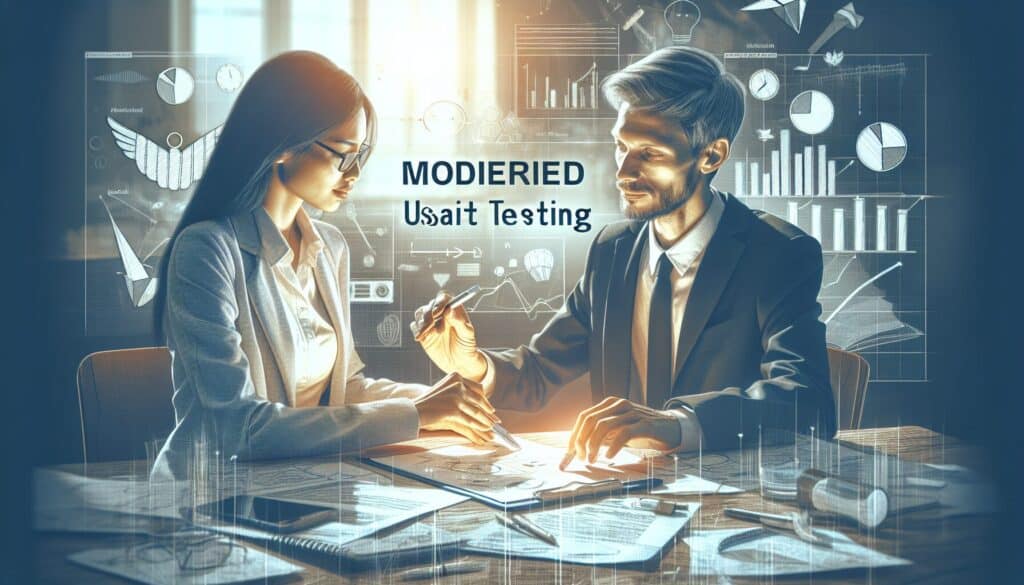A usability evaluation method where a trained moderator facilitates a session with a representative user who performs predefined tasks with a product or prototype, while the moderator observes, asks questions, and probes for insights.
- 方法: 人体工程学
主持可用性测试(现场或远程)

主持可用性测试(现场或远程)
- 设计评估, 设计思维, 人机交互, 可用性, 可用性测试, 用户体验(UX), 用户界面(UI), 用户测试, 以使用者為中心的設計
目标
如何使用
- 主持人引导参与者完成任务,鼓励他们大声思考,并提出后续问题,以了解他们的行为、思维过程和遇到的任何困难。会议可以在实验室进行(面对面),也可以使用屏幕共享和视频会议工具在线进行(远程)。
优点
- 可对用户行为进行深入的定性分析和直接观察;主持人可澄清说明并探究用户的理解;可发现用户可能不会报告的可用性问题;可根据用户互动情况灵活调整任务或问题。
缺点
- 每名参与者的成本和时间可能较高;主持人的存在可能会影响参与者的行为(霍桑效应);需要熟练的主持人避免引导参与者;时间安排可能具有挑战性。
类别
- 客户与营销, 产品设计, 质量
最适合:
- 深入了解用户如何与产品互动,找出具体的可用性问题,并收集对设计解决方案的定性反馈。
Moderated Usability Testing is particularly impactful in industries such as software development, consumer electronics, automotive design, and health tech, where understanding user interaction with products is paramount for successful outcomes. In the design and development phases of projects, this methodology is executed to iteratively refine products by involving participants who represent the target audience, enabling the collection of substantial qualitative data. Stakeholders such as UX designers, product managers, and engineers typically initiate this process, ensuring participants are briefed on objectives while also being encouraged to express their thoughts articulately. The environment can range from a controlled lab setting to flexible remote sessions, utilizing tools like Zoom or Microsoft Teams for effective communication. Feedback gathered can guide design iterations, revealing insights about user motivations, expectations, and pain points, which are often not apparent through surveys or analytics alone. The moderator’s capability to adapt questions in real-time based on participant reactions is invaluable for uncovering usability challenges that individuals may overlook in less interactive testing frameworks; as a result, this approach contributes to improved user satisfaction and product performance when applied effectively.
该方法的关键步骤
- Conduct a brief introduction to establish rapport with the participant.
- Introduce the task and explain the goals of the session.
- Instruct the participant to share their thoughts aloud while interacting with the product.
- Observe user interactions closely to identify any struggles or hesitations.
- Ask follow-up questions to clarify and probe into user behavior and thought processes.
- Monitor the time spent on each task, adjusting if necessary to maintain session flow.
- Encourage participants to express their emotions and feelings about their experiences.
- Introduce new tasks or variations if needed based on participant interactions.
- Conclude with a debriefing to discuss overall impressions and specific feedback.
专业提示
- Utilize user scenarios that reflect real-world contexts to ensure participants' feedback is grounded and relevant.
- Incorporate think-aloud protocols with clarifying prompts to elicit deeper cognitive insights into user decision-making processes.
- Implement a debriefing process immediately after sessions to capture fresh thoughts and sentiments about the usability experience.
历史背景
1986
(如果日期不详或不相关,例如 "流体力学",则对其显著出现的时间作了四舍五入的估计)。

相关文章
蒙特卡罗模拟
基于模型的测试
型号检查
混合方法研究
防错(Poka-Yoke)
任务简介测试